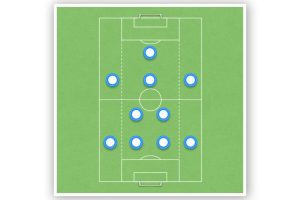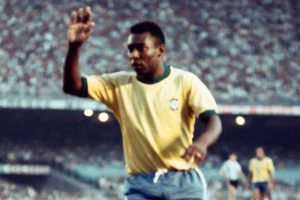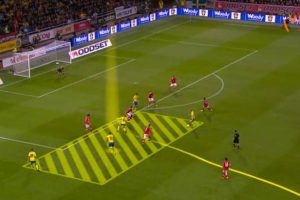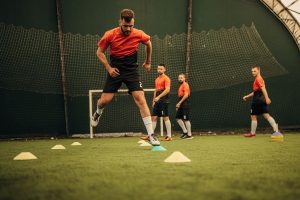Easiest Position in Soccer: Explained and Analyzed
When it comes to soccer, there are many positions that players can take on the field. Each position has its own unique set of responsibilities and challenges. However, some positions are easier to play than others. In this article, I will explore the easiest position in soccer and why it is considered the easiest.
As a soccer player myself, I have played in various positions on the field. From my experience, I have found that some positions require more physical exertion, while others require more mental focus. The easiest position in soccer is often considered to be the full-back position. Full-backs are responsible for defending the sides of the field and supporting the midfielders. They have less contact with the ball compared to other positions and do not have to run as much.
While the full-back position may be considered the easiest, it is still an important position on the team. Every player on the field plays a crucial role in the success of the team. As a full-back, you may not get as much attention or recognition as a striker or midfielder, but your role is just as important. In the following sections, I will delve deeper into why the full-back position is considered the easiest and what makes it an essential part of the team.
Easiest Position in Soccer
As a soccer enthusiast, I have often heard debates about the easiest position in soccer. While some argue that every position in soccer is equally demanding, others believe that some positions are easier than others. In this section, I will explore the subjectivity of the easiest position in soccer, the attributes of the easiest position, and the unique demands of the easiest position.
Subjectivity of Easiest Position
The easiest position in soccer is subjective and varies from person to person. Some might argue that the goalkeeper is the easiest position because they have to defend only one goalpost and have less contact with the ball. Others might argue that the full-back position is the easiest because they have less responsibility and run less than other positions. However, it is important to note that every position in soccer has its own unique demands and challenges.
Attributes of Easiest Position
The easiest position in soccer is often characterized by less physical demand and less contact with the ball. For example, the full-back position is considered the easiest because it requires less running and has less contact with the ball than other positions. Additionally, the goalkeeper position is considered less physically demanding because they do not have to run as much as other players.
Unique Demands of Easiest Position
While the easiest position in soccer might be less physically demanding and have less contact with the ball, it still has its own unique demands. For example, the full-back position might have less responsibility, but they still have to defend against opposing players and support their team’s attack. Similarly, the goalkeeper position might have less running, but they have to be constantly alert and make split-second decisions to prevent the opposing team from scoring.
In conclusion, the easiest position in soccer is subjective and varies from person to person. While some might argue that certain positions are easier than others, every position in soccer has its own unique demands and challenges. The easiest position in soccer is often characterized by less physical demand and less contact with the ball, but it still requires a certain level of skill and expertise.
Goalkeeper
As a goalkeeper, I am the last line of defense for my team. My responsibilities are critical to the success of the team. In this section, I will discuss the responsibilities, skills, attributes, challenges, and expectations of a goalkeeper.
Responsibilities
As a goalkeeper, my primary responsibility is to prevent the opposing team from scoring a goal. I must be able to anticipate the movements of the opposing team and position myself accordingly. I must also have quick reflexes and be able to use my hands to block shots that are aimed at the goal.
In addition to my defensive responsibilities, I also play a crucial role in the team’s offense. I am responsible for initiating the team’s attacks by distributing the ball to my teammates. I must also be able to communicate effectively with my teammates to ensure that they are in the right positions to receive the ball.
Skills and Attributes
To be a successful goalkeeper, I must possess a range of skills and attributes. These include:
- Agility and quick reflexes
- Excellent hand-eye coordination
- Good communication skills
- Strong leadership skills
- Good decision-making abilities
- Physical strength and endurance
Challenges and Expectations
Being a goalkeeper can be a challenging position. I must be able to handle the pressure of being the last line of defense and remain focused throughout the game. I must also be able to deal with the disappointment of conceding a goal and bounce back quickly.
There are also high expectations placed on me as a goalkeeper. My team relies on me to make crucial saves and keep the opposing team from scoring. I must also be able to initiate attacks and distribute the ball effectively to my teammates.
In conclusion, being a goalkeeper is a demanding but rewarding position. I must have a range of skills and attributes to be successful in this role. I must also be able to handle the challenges and expectations that come with being the last line of defense for my team.
Defenders
As a soccer player, I have played in different positions, but I have always had a special admiration for defenders. Defenders are the backbone of a team, and their role is crucial in stopping the opposition from scoring. In this section, I will discuss the different types of defenders and their responsibilities.
Center Backs
Center backs are the heart of the defense. They are usually the tallest and strongest players in the team and are responsible for stopping the opposition’s forwards from scoring. Center backs must have excellent positioning and be able to read the game well to anticipate the opposition’s attacks. They must also be able to tackle, block, and intercept the ball effectively.
Fullbacks
Fullbacks are the defenders who play on the flanks of the defense. Their primary responsibility is to stop the opposition’s wingers from crossing the ball into the box. Fullbacks must be physically fit and fast to keep up with the opposition’s wingers. They must also be able to tackle, block, and intercept the ball effectively.
Defensive Midfielders
Defensive midfielders are the midfielders who play in front of the defense. Their primary responsibility is to protect the defense and stop the opposition’s midfielders from creating chances. Defensive midfielders must have excellent positioning and be able to read the game well to anticipate the opposition’s attacks. They must also be able to tackle, block, and intercept the ball effectively.
In conclusion, defenders are an essential part of a soccer team. They must be physically fit, strong, and have excellent positioning and reading of the game. Defenders must also be able to tackle, block, and intercept the ball effectively to stop the opposition from scoring.
Midfielders
As a soccer player, I know that midfielders are the engine of the team. They play a crucial role in both defense and offense. Midfielders are responsible for maintaining possession and creating chances for their team. There are different types of midfielders, each with their own specific role.
Central Midfielders
Central midfielders are the backbone of the team. They play a pivotal role in maintaining possession and controlling the tempo of the game. They are responsible for distributing the ball to their teammates and creating opportunities for their team to score. Central midfielders need to have excellent passing skills, vision, and the ability to read the game.
Wingers
Wingers are midfielders who play on the flanks of the field. They are responsible for providing width to the team’s attack and creating opportunities for their team to score. Wingers need to have excellent dribbling skills, pace, and the ability to cross the ball accurately. They also need to be able to track back and defend when their team loses possession.
Attacking Midfielders
Attacking midfielders are midfielders who play a more advanced role. They are responsible for creating chances and scoring goals for their team. Attacking midfielders need to have excellent technical skills, vision, and the ability to take on defenders. They also need to be able to track back and defend when their team loses possession.
Midfielders need to be able to play under pressure and run for long periods of time. They are the link between defense and attack, and their role is crucial for the success of the team. Possession and passing are key factors in the midfield, and midfielders need to be able to create chances for their team.
In conclusion, midfielders are an essential part of any soccer team. They play a crucial role in maintaining possession, creating chances, and controlling the tempo of the game. Whether playing as a central midfielder, winger, or attacking midfielder, midfielders need to have excellent technical skills, vision, and the ability to play under pressure.
Forwards
As a soccer player, I know that the forward position is one of the most exciting positions on the field. As a forward, your primary objective is to attack the opponent’s goal and score. In this section, I will discuss the two types of forwards: Strikers and Wingers.
Strikers
Strikers are the primary goal scorers on the team. They are usually positioned in the center of the field and are responsible for finishing off plays created by their teammates. Strikers must be able to shoot accurately and quickly, and they must have excellent ball control skills. They also need to have a good understanding of the game and be able to read the play to anticipate where the ball will be.
Wingers
Wingers are players who play on the sides of the field and are responsible for creating opportunities for their teammates to score. They are usually fast, skillful players who can dribble past defenders and cross the ball into the box for their teammates to finish. Wingers also need to be able to track back and defend when the team is under pressure.
Overall, the forward position requires players to be fast, skilled, and have a good understanding of the game. It is one of the most exciting positions to play, but it also requires a lot of hard work and dedication to master.
Conclusion
In my opinion, the easiest position in soccer is the full-back position. This is because full-backs have less contact with the ball and carry less responsibility than other positions. They are not expected to score goals, but rather to defend and support the team’s attack when they can.
While other positions like center back and goalkeeper may also be considered easy, they require a specific set of skills and attributes that are not as common as those required for full-backs. Center backs need to be able to stop the opposition forwards, which is often helped by their physical build, while goalkeepers have the responsibility of preventing the opponents from scoring.
One advantage of playing as a full-back is that it allows players to focus on their defensive duties without worrying about scoring goals. This makes it a good position for players who are not as confident in their attacking abilities or who prefer a more defensive style of play.
Another advantage of playing as a full-back is that it requires less running and fitness compared to other positions like midfielders or forwards. This means that players who play in this position can conserve their energy and be fresher towards the end of the game.
Coaches also tend to cut full-backs more slack when it comes to mistakes, as the consequences of an error are not as severe as they would be for other positions. This can help players build their confidence and improve their game without the fear of being benched.
Overall, while every position in soccer requires a specific set of skills and attributes, the full-back position is a good starting point for beginners or players who prefer a more defensive style of play.







